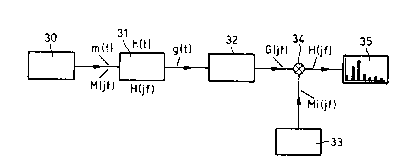Some of the information on this Web page has been provided by external sources. The Government of Canada is not responsible for the accuracy, reliability or currency of the information supplied by external sources. Users wishing to rely upon this information should consult directly with the source of the information. Content provided by external sources is not subject to official languages, privacy and accessibility requirements.
Any discrepancies in the text and image of the Claims and Abstract are due to differing posting times. Text of the Claims and Abstract are posted:
| (12) Patent Application: | (11) CA 2106973 |
|---|---|
| (54) English Title: | PROCESS FOR FINDING THE TRANSMISSION PROPERTIES OF AN ELECTRIC LINE |
| (54) French Title: | METHODE POUR DETERMINER LES PROPRIETES DE TRANSMISSION D'UNE LIGNE ELECTRIQUE |
| Status: | Deemed Abandoned and Beyond the Period of Reinstatement - Pending Response to Notice of Disregarded Communication |
| (51) International Patent Classification (IPC): |
|
|---|---|
| (72) Inventors : |
|
| (73) Owners : |
|
| (71) Applicants : |
|
| (74) Agent: | KIRBY EADES GALE BAKER |
| (74) Associate agent: | |
| (45) Issued: | |
| (86) PCT Filing Date: | 1992-03-19 |
| (87) Open to Public Inspection: | 1992-10-15 |
| Examination requested: | 1999-03-19 |
| Availability of licence: | N/A |
| Dedicated to the Public: | N/A |
| (25) Language of filing: | English |
| Patent Cooperation Treaty (PCT): | Yes |
|---|---|
| (86) PCT Filing Number: | PCT/DE1992/000239 |
| (87) International Publication Number: | DE1992000239 |
| (85) National Entry: | 1993-09-24 |
| (30) Application Priority Data: | ||||||
|---|---|---|---|---|---|---|
|
Abstract
The invention relates to a method for determining
the transmission characteristics (H(jf)) of an electric
line (2) in an ISDN system, in which a test signal (m(t))
is applied to the line (2) at one end, and at the other
end of the line (2) the received signal (g(t)) produced
owing to the test signal (m(t)) is evaluated.
In order to be able to carry out such a method
using a test signal having a crest factor of one with
relatively little cost, use is made as test signal of a
binary, bipolar random number sequence signal (m(t))
having the crest factor of one, and during a time inter-
val corresponding to the period of the test signal (m(t))
the received signal (g(t)) is scanned and subjected to a
Fourier transformation to obtain a spectral signal
(G(jf)); the latter is complexly multiplied by a refer-
ence spectrum Mi(jf) to obtain an output signal (H(jf)
which represents a measure of the transmission character-
istics of the line (31).
FIG. 1
Note: Claims are shown in the official language in which they were submitted.
Note: Descriptions are shown in the official language in which they were submitted.

2024-08-01:As part of the Next Generation Patents (NGP) transition, the Canadian Patents Database (CPD) now contains a more detailed Event History, which replicates the Event Log of our new back-office solution.
Please note that "Inactive:" events refers to events no longer in use in our new back-office solution.
For a clearer understanding of the status of the application/patent presented on this page, the site Disclaimer , as well as the definitions for Patent , Event History , Maintenance Fee and Payment History should be consulted.
| Description | Date |
|---|---|
| Inactive: IPC expired | 2015-01-01 |
| Inactive: IPC from MCD | 2006-03-11 |
| Application Not Reinstated by Deadline | 2001-08-20 |
| Inactive: Dead - Final fee not paid | 2001-08-20 |
| Deemed Abandoned - Failure to Respond to Maintenance Fee Notice | 2001-03-19 |
| Deemed Abandoned - Conditions for Grant Determined Not Compliant | 2000-08-18 |
| Notice of Allowance is Issued | 2000-02-18 |
| Letter Sent | 2000-02-18 |
| Notice of Allowance is Issued | 2000-02-18 |
| Inactive: Approved for allowance (AFA) | 2000-01-24 |
| Amendment Received - Voluntary Amendment | 1999-10-28 |
| Inactive: S.30(2) Rules - Examiner requisition | 1999-06-29 |
| Amendment Received - Voluntary Amendment | 1999-05-19 |
| Inactive: Application prosecuted on TS as of Log entry date | 1999-04-01 |
| Inactive: RFE acknowledged - Prior art enquiry | 1999-04-01 |
| Inactive: Status info is complete as of Log entry date | 1999-04-01 |
| All Requirements for Examination Determined Compliant | 1999-03-19 |
| Request for Examination Requirements Determined Compliant | 1999-03-19 |
| Inactive: Delete abandonment | 1998-04-28 |
| Deemed Abandoned - Failure to Respond to Maintenance Fee Notice | 1998-03-19 |
| Application Published (Open to Public Inspection) | 1992-10-15 |
| Abandonment Date | Reason | Reinstatement Date |
|---|---|---|
| 2001-03-19 | ||
| 2000-08-18 | ||
| 1998-03-19 |
The last payment was received on 2000-03-20
Note : If the full payment has not been received on or before the date indicated, a further fee may be required which may be one of the following
Patent fees are adjusted on the 1st of January every year. The amounts above are the current amounts if received by December 31 of the current year.
Please refer to the CIPO
Patent Fees
web page to see all current fee amounts.
| Fee Type | Anniversary Year | Due Date | Paid Date |
|---|---|---|---|
| Registration of a document | 1998-02-24 | ||
| MF (application, 6th anniv.) - standard | 06 | 1998-03-19 | 1998-03-11 |
| MF (application, 7th anniv.) - standard | 07 | 1999-03-19 | 1999-03-11 |
| Request for examination - standard | 1999-03-19 | ||
| MF (application, 8th anniv.) - standard | 08 | 2000-03-20 | 2000-03-20 |
Note: Records showing the ownership history in alphabetical order.
| Current Owners on Record |
|---|
| TEKTRONIX, INC. |
| Past Owners on Record |
|---|
| ANDREAS WOLF |
| HANS WERNER ARWEILER |